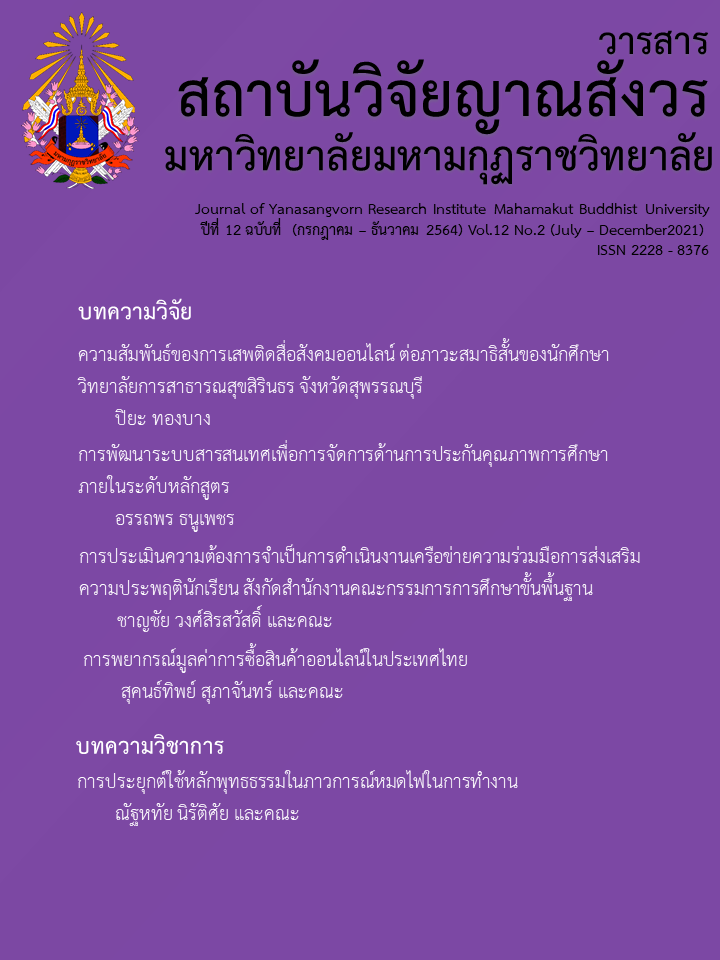THE INHERITANCE OF CULTURE AND TRADITION OF THAI SONG DAM IN RATCHABURI PROVINCE
Main Article Content
Abstract
This research entitled “The Inheritance of Culture and Tradition of Thai Song Dam in Ratchaburi Province”. The objectives of the research were 1. to analyze the inheritance of culture and tradition of Thai Song Dam in Ratchaburi Province; 2. to propose the approaches for inheritance of culture and tradition of Thai Song Dam in Ratchaburi Province. The research methods quantitative and qualitative methods. The samples of the research, Were Thai Song Dam people with18 years old and above. They domiciled in the area of 6 sub-districts, Ratchaburi Province. The sample size set up by using Yamane's method was 365 people. The target group of each sub-district consisted of 3 community leaders, 3 village philosophers and 3 youth leaders, totaling 54 people. The instruments used in the research included the questionnaire and interview form. The collected data were analyzed by using percentage, mean and standard deviation. The results of the research were as follows:
- 1. The samples inherited Thai Song Dam’s Culture and Tradition in all 3 aspects and at a moderate level. The averages sorted from highest to lowest were: The cultural practices; a cultural dissemination, cultural conservation and cultural activities were in a high level. The means from greatest to lowest were: 1. Buddhist monk ordination was important for men as a substitute for the merit of their parents; 2. Offering food to the monks in the morning to dedicate merit for the deceased ancestors; and 3. Being proud for dressing in Thai Song Dam’s clothes. For the target group, it was found that 1. There were cultural practices:-Traditional Thai Song Dam’s traditions, and paying respects to the ancestor spirits (Phi Ruen) in ceremonies of Sen Ruean, Pattong, funerals, weddings, housewarming, summoning and dressing, together with using Thai Song Dam’s language to communicate within their families and communities. Besides, there were some cultures and traditions accepted from Buddhism and Brahmins such as, ordination, Chula Kathin, offering food to monks, New Year's Day and Songkran Festival. 2. There was a belief in traditional culture and tradition conservation. They believed that it was a good way to showed the children's gratitude towards their ancestor spirits. 3. There was the dissemination of village philosophers through telling, informing, teaching about culture and tradition, including the beliefs about Phi Ruen. The community leaders also supported, promoted and participated in various activities, and the youths disseminated by dancing “IngonFon Can”, being as a tour guide to see Thai Song Dam’s way of life and informing through social media.
2. The samples proposed some approaches to achieve the inheritance of Thai Song Dam’s culture and tradition, and the data collection showed 28 aspects. According to the approach of inheritance, it was arranged in order and emphasized on these matters; including 1. The government agencies and the private sectors should support Thai Song Dam for cultural and traditional activities. 2. The community should organize activities for cultural and traditional transmission to the next generation including those interested in learning and visiting the community to generate income and increase knowledge for the community. 3. They needed talented people as being healers including, Sen Ruean, Sork Kwan, Pang Kwan, Mae Mod and Kheuay (son in law). For target population, they also suggested as follows: 1. The government agencies should provide teachers for teaching Thai Song Dam’s language in all four skills, together with training for traditional dance “Ram Kan” on youths. 2. The parents should encourage their children to participate in cultural and traditional activities of Thai Song Dam.
Article Details
References
กานต์ทิตา สีหมากสุก. (2558). วิเคราะห์ปัจจัยการดำรงอยู่และการเปลี่ยนแปลงความเชื่อในพิธีกรรมของไทยทรงดำ : กรณีศึกษาเขตตำบลหนองปรง อำเภอเขาย้อย จังหวัดเพชรบุรี (ดุษฎีนิพนธ์ปรัชญาดุษฎีบัณฑิต). มหาวิทยาลัยบูรพา, ชลบุรี
ซุ้ม คุ้มสวัสดิ์ ไพรัตน์ บัวบังใบ และ อุไร แห่งหน. ปราชญ์ชาวบ้านบ้านหัวเขาจีน ณ ศูนย์การเรียนรู้วัฒนธรรมไทยทรงดำ ต. ห้วยยางโทน อ. ปากท่อ จ. ราชบุรี. (6 กุมภาพันธ์ 2564). สัมภาษณ์.
น้ำทิพย์ ภูธนชัย. (2550).การปรับตัวทางวัฒนธรรมของกลุ่มชาติพันธุ์ไทยโซ่งบ้านตลาดควาย อำเภอจอมบึงจังหวัดราชบุรี (วิทยานิพนธ์ศิลปศาสตรมหาบัณฑิต), มหาวิทยาลัยราชภัฏธนบุรี, กรุงเทพ.
พระครูวิบูลกิจสุนทร. (พระสงฆ์กับวัฒนธรรมประเพณีไทยทรงดำเจ้าอาวาสวัดวาปีสุทธาวาส ต. จอมบึง อ. จอมบึง จ.ราชบุรี). (30 มกราคม 2564).สัมภาษณ์.
พระปลัดสุเทพ สุเทโว (ทองแคล้ว). (2554). บทบาทพระสงฆ์ในการส่งเสริมอนุรักษ์วัฒนธรรมไทยทรงดำ ในตำบลดอนคา อำเภอบางแพ จังหวัดราชบุรี. (วิทยานิพนธ์พุทธศาสตรมหาบัณฑิต). มหาวิทยาลัยมหาจุฬาลงกรณราชวิทยาลัย, กรุงเทพมหานคร
ภาณุวัช ม่วงนวล. (2563). ความร่วมมือในการจัดการปัญหาการทำลายทรัพยากรธรรมชาติในพื้นที่ตำบลน้ำพาง อำเภอแม่จริม จังหวัดน่าน (การค้นคว้าอิสระรัฐศาสตรมหาบัณฑิต) .มหาวิทยาลัยธรรมศาสตร์, กรุงเทพมหานคร.
เรณู เหมือนจันทร์เชย. (2561). จัดการความรู้ในพิธีเสนเรือนของไทยทรงดำ. วารสารมหาวิทยาลัยศิลปากร, 38(1), 7-9.
วิทยา วิสูตรเรืองเดช. (2561). การศึกษาวัฒนธรรมไทยทรงดำ : อัตลักษณ์ชาวไทยทรงดำ ตำบลบ้านดอน อำเภออู่ทอง จังหวัดสุพรรณบุรี.(รายงานผลการวิจัย).กรุงเทมหานคร.
สุมิตร ปิติพัฒน์ และเสมอชัย พูลสุวรรณ. (2542). ชุมชนและการสืบทอดวัฒนธรรมของไทใหญ่ในประเทศสหภาพพม่า (รายงานวิจัย). กรุงเทพมหานคร: สำนักงานคณะกรรมการการวัฒนธรรมแห่งชาติ.
เอื้อมพร โตภาณุรักษ์กุล. (2559). การวิจัยเชิงปฏิบัติการแบบมีส่วนร่วมในการอนุรักษ์และสืบทอดภูมิปัญญาผ้าทอไทยทรงดํา. วารสารศิลปากรศึกษาศาสตร์วิจัย, 8(2), 98-99.
Baron, R. A., & Greenberg, J. (1997). Behavior in organizations: Understanding and managing the human side of work: Color transparencies. Prentice Hall.
Cronbach, L. J., & Furby, L. (1970). How we should measure" change": Or should we?. Psychological bulletin, 74(1), 68 – 80.
Denzin, N. K. (2017). The research act: A theoretical introduction to sociological methods. Transaction publishers.
Yamane, T. (1967). Statistics: An introductory analysis (No. HA29 Y2 1967).


